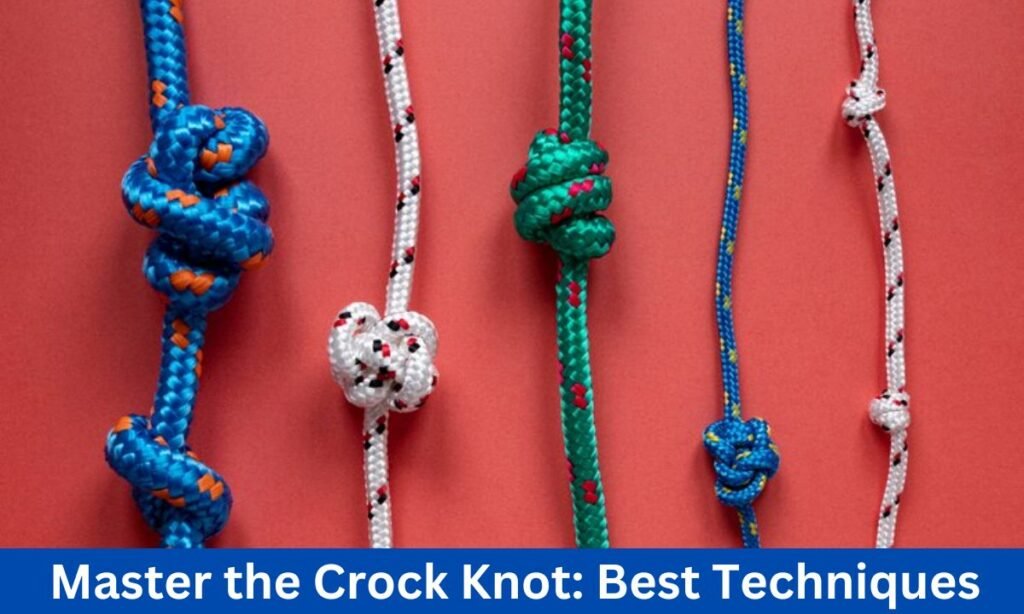
When it comes to securing objects or ensuring that knots remain tight and functional, the Crock Knot stands as one of the most reliable and versatile options available. This knot, known for its simplicity and strength, is a favored choice among sailors, climbers, and even in everyday household tasks. In this article, we will explore the best techniques for tying the Crock Knot, delve into its practical applications, and highlight why it should be a knot in your repertoire.
Understanding the Crock Knot
The Crock Knot, also known as the Cross Knot, is a binding knot that is particularly effective in creating a non-slip loop. Its design ensures that the knot remains secure under tension, making it ideal for various applications. Unlike some other knots, the Crock Knot is easy to untie, even after being subjected to significant pressure. This characteristic makes it a preferred choice for situations where quick release is necessary.
History and Evolution
The Crock Knot has roots in ancient nautical practices, where it was commonly used to secure sails and rigging. Over time, its utility has extended beyond maritime use, finding a place in outdoor sports, camping, and even in creative arts like macramé. Its evolution has been driven by the need for a knot that is both strong and easy to manage, regardless of the conditions.
Best Techniques for Tying the Crock Knot
To master the Crock Knot, it is essential to follow a step-by-step approach that ensures precision and reliability. Here is a detailed guide to tying this knot effectively:
Step 1: Create the Initial Loop
Start by forming a loop with the rope or cord you are using. Ensure that the loop is large enough to work with comfortably but not too large that it becomes unwieldy.
Step 2: Cross the Ends
Take the working end of the rope (the end you will be moving) and cross it over the standing part (the end that remains stationary). This action creates the first cross, which is the foundation of the Crock Knot.
Step 3: Form the Second Loop
After crossing the ends, form a second loop by bringing the working end around and underneath the standing part. This loop should mirror the first, ensuring symmetry and balance in the knot.
Step 4: Tighten the Knot
Once both loops are formed, pull on the working end while holding the standing part steady. This action tightens the knot, securing the loops in place. Ensure that the knot is snug but not so tight that it becomes difficult to untie.
Step 5: Inspect and Adjust
Finally, inspect the knot to ensure that it is correctly formed. The loops should be even, and the knot should hold firm without slipping. If necessary, make slight adjustments to ensure optimal security.
Practical Applications of the Crock Knot
The versatility of the Crock Knot makes it suitable for a wide range of practical applications. Here are some of the most common uses:
1. Camping and Outdoor Activities
For outdoor enthusiasts, the Crock Knot is invaluable. It can be used to secure tents, tarps, and other gear, ensuring that they remain in place even in adverse weather conditions. Its quick-release feature is particularly useful when you need to pack up camp quickly.
2. Boating and Sailing
In nautical settings, the Crock Knot is often used to secure lines and rigging. Its non-slip nature ensures that sails and other equipment remain secure, even in high winds or rough seas. Sailors appreciate the ease with which the knot can be untied, allowing for quick adjustments when necessary.
3. Climbing and Mountaineering
Climbers rely on knots that provide security without the risk of slipping. The Crock Knot is ideal for tying ropes and securing gear, providing the confidence needed for safe ascents and descents. Its reliability under tension makes it a go-to knot in critical situations.
4. Household Use
Beyond its outdoor applications, the Crock Knot is also useful in everyday household tasks. Whether you need to tie up a bundle of newspapers, secure a load in the back of a truck, or fasten a garden hose, the Crock Knot offers a reliable solution.
5. Creative and Decorative Arts
In the world of arts and crafts, the Crock Knot is used in macramé, jewelry making, and other decorative projects. Its neat and symmetrical appearance adds an aesthetic quality to designs, while its strength ensures that creations remain intact.
Tips for Perfecting the Crock Knot
While the Crock Knot is relatively simple to tie, a few tips can help ensure that you achieve the best results every time:
1. Practice Regularly
As with any skill, practice is key to mastering the Crock Knot. Regularly tying the knot in different scenarios will help you become proficient and confident in its use.
2. Use the Right Material
The type of rope or cord you use can impact the effectiveness of the Crock Knot. Choose a material that is appropriate for the task at hand—sturdy and with minimal stretch for heavy-duty applications, and more flexible for decorative purposes.
3. Maintain Tension While Tying
To ensure that the knot holds firm, maintain consistent tension while tying. This practice prevents the knot from loosening over time and ensures that it remains secure under load.
4. Inspect Before Use
Before relying on the Crock Knot for any critical application, take a moment to inspect the knot. Ensure that it is properly tied and that there are no loose ends or irregularities that could compromise its strength.
Conclusion
The Crock Knot is a versatile and reliable knot that deserves a place in the skillset of anyone who regularly ties knots. From camping and sailing to household chores and creative projects, its applications are numerous and varied. By mastering the techniques outlined in this article, you can ensure that your Crock Knot is always secure, easy to untie, and perfectly suited to the task at hand.

